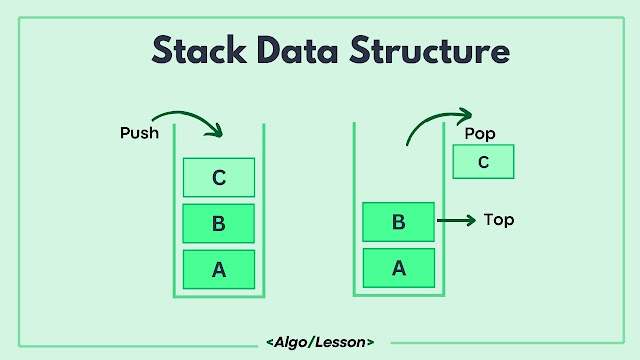When an element is pushed onto the stack, it becomes the new top element. Subsequent pushes place new element on the top, effectively forming a sequence. The pop operation removes the top element, revealing the next element in the stack. This behavior ensures that the most recently added item is always the first to be removed as the insertion and deletion of an element happens from the same end (top).
Additionally, a stack supports other operations like peek, enabling us to view the top element without removing it, and methods to determine whether the stack is empty (isEmpty) and to know its current size (size)
A stack can be implemented using either an array or linked lists. Arrays offer simplicity and constant-time access to elements but have a fixed size, whereas linked lists provide flexibility in size but might involve more memory overhead due to their node structure.
Read our detailed article on stack data structure to understand the implementation in detail.
List of Common Stack Operations:
- push(element): Adds an element to the top of the stack.
- pop(): Removes and returns the element from the top of the stack.
- peek() or top(): Returns the element at the top of the stack without removing it.
- isEmpty(): Checks if the stack is empty.
- size(): Determines the number of elements in the stack.
These operations are fundamental for managing and manipulating elements within a stack.
Exploring Applications of Stack Data Structure.
Stack is a fundamental data structure in computer science, and finds its utility across a wide array of applications.
1. Function Calls and Recursion:
Stacks play a crucial role in managing function calls in programming languages. When a function is called, its context, including local variables and execution point, is pushed onto the call stack. As subsequent functions are called or when recursion occurs, new contexts are stacked on top. Upon returning from a function or completing recursion, the corresponding context is popped off the stack, allowing the program to resume execution from the previous point.
2. Expression Evaluation:
In evaluating mathematical expressions, stacks are used to handle parentheses, operators, and operands. The infix-to-postfix conversion and postfix expression evaluation utilize stacks to ensure proper sequencing and precedence of operations.
3. Undo Mechanisms in Text Editors:
Text editors often implement undo functionalities using stacks. Each edit operation is pushed onto the stack, allowing users to revert changes sequentially. When the undo command is invoked, the most recent edit is popped off the stack, effectively undoing the action.
4. Browser History in Web Browsing:
The back/forward functionality in web browsers uses stacks. Visited web pages are pushed onto the history stack. Clicking the back button pops the last visited page, simulating the LIFO behavior of a stack.
5. Memory Management in Operating Systems:
Operating systems utilize stacks for memory management. The system stack, responsible for managing function calls and storing local variables, follows the stack data structure model. Additionally, the call stack helps in managing memory allocation and deallocation through its LIFO nature.
Advantages of Stack Data Structure.
- Stacks are simple to implement and understand, making them easy to use in various applications.
- They offer efficient data retrieval and storage for specific operations like push, pop, and peek, with a constant time complexity O(1).
- Stacks support automatic memory management, especially in programming languages that use stack-based memory allocation and deallocation.
- Stacks are useful for reversing a sequence of elements efficiently due to their LIFO behavior.
Disadvantages of Stack Data Structure.
- Stack provides limited access to elements. Direct access to arbitrary elements, other than the top one, is not possible without sequentially popping off elements.
- If implemented using arrays, stacks have a fixed maximum capacity, making them prone to overflow issues when trying to add elements beyond the size limit.
- Stack is not a suitable data structure for performing certain operations like searching and sorting as it is difficult to change the order of stack elements.











No comments
Post a Comment